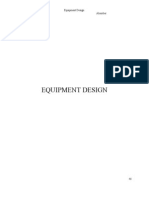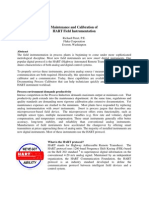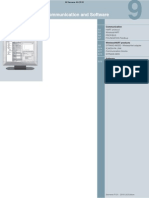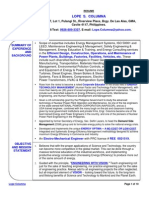0 ratings0% found this document useful (0 votes)
120 viewsbEAMEX hART PDF
bEAMEX hART PDF
Uploaded by
ed_maltosA HART handheld is an essential tool in plants deploying HART instrumentation. There are different ways and levels of integrating the HART protocol into a plant. The simplest integration would be to continue using the standard analog control system.
Copyright:
© All Rights Reserved
Available Formats
Download as PDF, TXT or read online from Scribd
bEAMEX hART PDF
bEAMEX hART PDF
Uploaded by
ed_maltos0 ratings0% found this document useful (0 votes)
120 views5 pagesA HART handheld is an essential tool in plants deploying HART instrumentation. There are different ways and levels of integrating the HART protocol into a plant. The simplest integration would be to continue using the standard analog control system.
Original Title
bEAMEX hART.pdf
Copyright
© © All Rights Reserved
Available Formats
PDF, TXT or read online from Scribd
Share this document
Did you find this document useful?
Is this content inappropriate?
A HART handheld is an essential tool in plants deploying HART instrumentation. There are different ways and levels of integrating the HART protocol into a plant. The simplest integration would be to continue using the standard analog control system.
Copyright:
© All Rights Reserved
Available Formats
Download as PDF, TXT or read online from Scribd
Download as pdf or txt
0 ratings0% found this document useful (0 votes)
120 views5 pagesbEAMEX hART PDF
bEAMEX hART PDF
Uploaded by
ed_maltosA HART handheld is an essential tool in plants deploying HART instrumentation. There are different ways and levels of integrating the HART protocol into a plant. The simplest integration would be to continue using the standard analog control system.
Copyright:
© All Rights Reserved
Available Formats
Download as PDF, TXT or read online from Scribd
Download as pdf or txt
You are on page 1of 5
Getting the most
from the HART
handheld device
www.beamex.com
info@beamex.com
Beamex
Calibration White Paper
BEAMEX Calibration White Paper
Getting the most from the HART handheld device 2 www.beamex.com
A device like the Beamex MC6 offers the highest
functionality and automation for configuration and
calibration of wired or wireless HART transmitters.
A
HART handheld is an essential tool in plants
deploying HART instrumentation. But what is
a HART handheld? What are the differences
between various handheld brands and what are the practical
considerations that should be taken into account when
selecting one? Finally, how does one get the most from the
HART handheld?
The difference between calibration and
configuration
Before beginning a discussion on HART handhelds, it is
important to take a short look into a terminology issue
that often causes confusion that is the meaning of and
difference between configuration and calibration.
According to international standards; calibration is a
comparison of the device under test against a traceable
reference instrument (calibrator) and documentation of this
comparison. Although, formally, the calibration does not
include any adjustments, in practice the possible adjustment
is often included in the process of calibration. So, in order to
do a calibration of a HART device, a traceable metrological
reference device (calibrator) is needed.
Configuration means using the digital communication
protocol to change settings inside the field device.
Configuration can be done with a configuration software
or handheld communicator. It is important to remember
that a communicator alone cannot be used for metrological
calibration to check the accuracy of a field device.
Configuring parameters of a HART transmitter with a
communicator is not metrological calibration and it does
not assure accuracy. For a real metrological calibration, a
traceable reference standard (calibrator) is always needed.
Configuration is not the same as calibration.
HART integration into a plant
There are different ways and levels of integrating the HART
protocol into a plant. The simplest integration would be
to continue using the standard analog control system and
use HART instrumentation that is configurable via HART
communication (a handheld device or communicator).
Another way would be to use an analog control system, but
have another digital asset management system that uses the
HART protocol to gather diagnostic and other valuable
information from field instruments. The highest level of
integration would be to use a fully HART enabled ecosystem
from the field devices to the control system via all-digital
signals with no analog mA signals.
How to calibrate a HART transmitter
It is good to remember that a HART transmitter has different
outputs that can be used and calibrated; that is, the analog
mA output and the digital HART output(s). In most cases,
the analog output is still being used among end users.
In order to calibrate the analog output, the transmitter
input signal needs to be generated or measured while
Getting the most
from the HART handheld device
For a real metrological calibration,
a traceable reference standard
(calibrator) is always needed.
BEAMEX Calibration White Paper
Getting the most from the HART handheld device 3 www.beamex.com
simultaneously measuring the transmitter output. For
example, generate a pressure input, measure that accurately
with a calibrator and at the same time measure the analog
mA output with a meter.
If calibrating the digital HART output, the calibration
process alters slightly. The generation/measurement of the
transmitter input in the same way as for an analog transmitter
using a calibrator is still needed.
However, to be able to see what the transmitter digital
HART output is, some kind of HART communicator
showing the digital HART signal is required.
In the case of analog or digital output, one would go
through the range of the transmitter at a few intervals
and record the input and output signals to document the
calibration. If there are too many errors found during the
calibration, the transmitter is trimmed via HART protocol
and a new calibration performed.
Practical considerations for the HART handheld
For the configuration of HART transmitters, it is possible
to use a PC with a HART modem and related software, but
it is often more practical to use a mobile handheld HART
communicator. This article will focus on the handhelds.
If one wants to work with a HART transmitter that is
not connected to field supply voltage, some kind of power
supply to power up the transmitter is needed. Some HART
handhelds do not have a built-in loop supply, so there
should be an external loop supply with required impedance
(nominally 250 ohms) for the HART communication to
work. However, some handhelds do have a built-in loop
power supply as well as built-in impedance, meaning that
no additional equipment to communicate is required. If
configuration or calibration of transmitters occurs before
installation in the field, power is taken from the DCS
(distributed control system).
In a case where a transmitter is connected in the field
to the power supply coming from DCS, no additional
power supply device is needed. However, it is important to
remember that the loop supply coming from the DCS does
not always include the required impedance for the HART
communication to work, especially if the control system is
made for analog signals. If the handheld operates according
to the HART standard specification, its communication
signal level must not be too low (due to excessively low
impedance), as that could be noise instead of a real, reliable
signal. In that case, additional impedance to the loop may
need to be added. While connected to the transmitter in
the field, physical connection at the transmitter is not
needed. The connection can be anywhere in the loop of the
transmitter.
Functionality of a HART handheld
There are two important aspects of a Device Description
(DD) published by HART Communication Foundation
(HCF) and the available commands of a HART handheld.
Some handhelds only support a limited amount of HART
devices and commands, while others support all of the
HART devices and full command structure of the DD
file, including Methods. The support for all of the device-
specific advanced features requires support for the entire
DD structure. Therefore, it is important to ensure that the
chosen handheld supports the installed and future HART
device base.
The availability and pricing for the future updates of
the DDs for new transmitters vary. If restricted only to the
Universal Commands, limited support is offered. Differences
also exist between handhelds in the support for the HART
methods. These methods are like small wizards built in the
DD file making it easier to do several configuration steps.
Measuring mA signal
As the HART transmitter is most often used with the
analog mA signal, a device for measuring the mA signal is
required. If the handheld does not have mA measurement
functionality, another device for the mA measurement
needs to be used. Some handhelds offer accurate mA
measurements, but many of them do not. The mA
measurement is also something that needs to be measured
With the Beamex MC6, you can generate/
measure the HART transmitters input at
the same time as the analog or digital
output is read.
BEAMEX Calibration White Paper
Getting the most from the HART handheld device 4 www.beamex.com
if a calibration of the transmitters mA output is desired.
When HART transmitters are calibrated, it is good to
remember that output should be measured, whether it is
an analog mA signal or digital variable. It is also important
to remember that in order to calibrate, a traceable reference
standard (calibrator) is required to measure or source
the transmitters input. If the handheld does not offer
this functionality, an additional calibrator device for the
calibration will be needed.
Advanced HART handhelds
A few advanced handhelds even offer a fully multifunctional
process calibrator in the same device as the HART handheld.
These devices can be used not only for configuring but
also for calibrating and trimming of HART devices, such
as temperature and pressure transmitters. The typical
procedure with these devices is that if there is a need for
trimming after the first As Found calibration is done,
the HART trim methods are run. After trimming the
transmitter, a second calibration, As Left, is performed.
Some handheld devices are documenting devices, so they
can save the calibration results into memory and later upload
results to PC software. Furthermore, some handhelds can
also read and document the configurations from the HART
device and upload this into a PC for archiving or printing.
Usability and the user interface are important features to
consider when choosing a handheld, as there are differences
in the ease of use. Some devices are larger and some are
smaller; some have a small display and some have a bigger.
A touch screen user interface with color display is available
in the most modern handhelds, such as in the Beamex MC6.
WirelessHART
The WirelessHART standard is the latest offer from HART.
Although a WirelessHART instrument transmits wirelessly, it
does have screw terminals and configuration and calibration
is done via the screw terminals. Therefore, a handheld for
WirelessHART transmitters does not need to be wireless.
The handheld must, however, be able to support the HART
7 standard that the WirelessHART uses, and obviously
the handheld must have the DD files to support the
WirelessHART transmitter models that are used.
BEAMEX Calibration White Paper
Getting the most from the HART handheld device 5 www.beamex.com
Durability and support
As the handheld is often used in field environments, the
robustness and water/dust protection should be taken into
account. While some handhelds seem to be simply based on
standard Pocket PCs (made for office use), others are made
for use in industrial applications and have good ratings for
water and dust protection (IP or NEMA classification).
Some handhelds are suitable for use in hazardous (Ex) areas
the Beamex MC5-IS is one of them.
Pocket PC-based handhelds are not necessarily suitable for
industrial/factory field environments and they often do not
have built-in HART modem; an external modem solution
needs to be used. Typically they will not offer built-in loop
supply/impedance either, so one may end up carrying
several devices.
A handful of the most modern handhelds, the Beamex
MC6 among others, have a multifunctional process
calibrator and HART communicator in the same device, and
offer field communication for FOUNDATION Fieldbus
and/or Profibus devices as well.
After-sales support is a final element to take into account
when comparing handhelds. All in all, there are many types
of HART handhelds available on the market. Be sure to review
the features and suitability for current and future needs.
Beamex MC6 advanced calibrator
and field communicator
The new Beamex MC6 is a device combining a field
communicator and a very accurate multifunctional process
calibrator with documentation.
With the Beamex MC6, you can generate/measure the
HART transmitters input at the same time as the analog
or digital output is read. Both can be done simultaneously
and the results can be automatically stored into the MC6
memory for later reference or uploaded to calibration
software.
For configuration of smart transmitters, the MC6
includes a field communicator for HART, WirelessHART,
FOUNDATION Fieldbus H1 and Profibus PA protocols. All
required electronics are built-in, including modems, power
supply and required impedances for the protocols.
The Beamex MC6 can be used both as a communicator
for configuration and as a calibrator for calibration of smart
instruments with the supported protocols.
While a normal HART communicator can be used to
configure and read the HART digital output, it alone cannot
be used for calibration or trimming of the transmitter; an
additional calibrator would be needed. This means that one
ends up with two separate devices without any automatic
calibration procedure or documentation. Therefore, a device
like the Beamex MC6 offers the highest functionality and
automation for configuration and calibration of wired or
wireless HART transmitters.
To watch video demonstrations of a HART handheld,
visit: http://www.youtube.com/beamexcalibration.
___________
All specifcations are subject to change without prior notice.
Beamex Oy Ab 2013. All rights reserved.
Beamex is a trademark of Beamex Oy Ab.
HART
is a registered trademark of the HART communication
Foundation.
You might also like
- Range Rover Owners Handbook (2004)Document290 pagesRange Rover Owners Handbook (2004)mavioglu71% (7)
- Ibrahim Dincer - Thermodynamics - A Smart ApproachDocument673 pagesIbrahim Dincer - Thermodynamics - A Smart Approachmdtarequl.islam100% (12)
- Design of AbsorberDocument18 pagesDesign of AbsorberAdeel Ahmed100% (2)
- 항공훈련기관 (Ato) - icao Doc 9841 Manual of AtoDocument112 pages항공훈련기관 (Ato) - icao Doc 9841 Manual of AtoOlgaNo ratings yet
- Calibrating Hart WirelessDocument5 pagesCalibrating Hart WirelessCyrix.OneNo ratings yet
- 1.6 Configuring Intelligent Devices: J. BergeDocument7 pages1.6 Configuring Intelligent Devices: J. BergeRoger Salomon QuispeNo ratings yet
- Beamex White Paper - Configuring and Calibrating Smart Instruments PDFDocument4 pagesBeamex White Paper - Configuring and Calibrating Smart Instruments PDFshareyhouNo ratings yet
- HART BasicsDocument17 pagesHART BasicsCenthil ParthibarajNo ratings yet
- Hart ICDocument7 pagesHart ICchinawinneryuNo ratings yet
- Understanding HartDocument13 pagesUnderstanding HartSudhir DyavanapelliNo ratings yet
- The Benefits of HART Protocol Communication in Smart Instrumentation SystemsDocument5 pagesThe Benefits of HART Protocol Communication in Smart Instrumentation SystemsShella Yulia RachmanNo ratings yet
- Hart Transmitter Calibration PDFDocument1 pageHart Transmitter Calibration PDFazitaggNo ratings yet
- HART DsiDocument8 pagesHART DsiMuhammadAsimNo ratings yet
- HART ProtocolDocument15 pagesHART ProtocolrmeeeNo ratings yet
- Smart Is Process Jargon That Describes AnyDocument16 pagesSmart Is Process Jargon That Describes AnyDevidutta PandaNo ratings yet
- Hart 475Document16 pagesHart 475lequydueuNo ratings yet
- Wa0016Document12 pagesWa0016Shreya SawantNo ratings yet
- 3.4 HART ProtocolDocument15 pages3.4 HART ProtocolMani KandanNo ratings yet
- Block Diagram of A Smart Transmitter: "Prepare Notes For SENSOR, ADC, MICROPROCESSOR, and DAC"Document2 pagesBlock Diagram of A Smart Transmitter: "Prepare Notes For SENSOR, ADC, MICROPROCESSOR, and DAC"hareesh babuNo ratings yet
- What Is HARTDocument5 pagesWhat Is HARTsvanjaleNo ratings yet
- Fluke HART Transmitter CalibrationDocument16 pagesFluke HART Transmitter CalibrationhaitoecheNo ratings yet
- HartDocument6 pagesHartMayur AhujaNo ratings yet
- Hart Networks 0402Document32 pagesHart Networks 0402Dhiraj KapoorNo ratings yet
- The Benefits of HART Protocol Communication in Smart Instrumentation SystemsDocument5 pagesThe Benefits of HART Protocol Communication in Smart Instrumentation SystemsMoises Bautista CastroNo ratings yet
- Introduction To Smart TransmittersDocument3 pagesIntroduction To Smart Transmitterssleepfox9No ratings yet
- HARTDocument10 pagesHARTHalimi AyoubNo ratings yet
- HartDocument10 pagesHartSandhya RaghunathNo ratings yet
- CP0287 20-Mar-2012 RM01Document7 pagesCP0287 20-Mar-2012 RM01Shashank KumarNo ratings yet
- The Benefits of HART Protocol Communication in Smart Instrumentation SystemsDocument4 pagesThe Benefits of HART Protocol Communication in Smart Instrumentation SystemsBijay KrishnaNo ratings yet
- DC-14 Ch11 Vivek Ver2Document9 pagesDC-14 Ch11 Vivek Ver2Florian_AngererNo ratings yet
- Hart Transmitter Calibration: Application NoteDocument8 pagesHart Transmitter Calibration: Application NoteThulasi Raman KowsiganNo ratings yet
- HartDocument11 pagesHartAnirban BanerjeeNo ratings yet
- HARTDocument6 pagesHARTMammar SoulimaneNo ratings yet
- Role of HART 1711639642Document6 pagesRole of HART 1711639642Richard PudadaNo ratings yet
- About The HART ProtocolDocument13 pagesAbout The HART ProtocolChanakya KatyalNo ratings yet
- Field Bus Etc NotesDocument12 pagesField Bus Etc NotesKrishna Vijay KalepuNo ratings yet
- WP - EDDL CalibrationtrimDocument13 pagesWP - EDDL CalibrationtrimDamien NeylonNo ratings yet
- 01.HART Communication Tutorial Part 1 - Inst ToolsDocument13 pages01.HART Communication Tutorial Part 1 - Inst ToolsHARSHITH SNo ratings yet
- HART Out of ValueDocument32 pagesHART Out of ValueLiu ZhongjieNo ratings yet
- HART Communication Protocol Overview - Inst ToolsDocument10 pagesHART Communication Protocol Overview - Inst ToolsAvinash ShuklaNo ratings yet
- What Is HART? (: Highway Addressable Remote Transducer)Document8 pagesWhat Is HART? (: Highway Addressable Remote Transducer)Manish DangiNo ratings yet
- HART Communication ProtocolDocument6 pagesHART Communication Protocoldzfaresanes7777No ratings yet
- Hart EndressDocument8 pagesHart EndresssuudonNo ratings yet
- Hart Communication ProtocolDocument12 pagesHart Communication ProtocolZujali ValopiNo ratings yet
- Hart ProtocolDocument13 pagesHart ProtocolRey-an A. MorenoNo ratings yet
- Smart Transmitter HartDocument31 pagesSmart Transmitter HartNur Aleeya FazlinNo ratings yet
- FF Hart Functional ComparisonDocument15 pagesFF Hart Functional ComparisonjggirishNo ratings yet
- Communication & SoftwareDocument26 pagesCommunication & SoftwarejadetorresNo ratings yet
- Eng SCH - Buses 202Document4 pagesEng SCH - Buses 202shadi22No ratings yet
- Hart and Field BusDocument36 pagesHart and Field Buspriyasasen23No ratings yet
- 1006 MTL 4840 HartDocument14 pages1006 MTL 4840 HartAlonso CoradoNo ratings yet
- Using MODBUS For Process Control and AutomationDocument1 pageUsing MODBUS For Process Control and AutomationazrinoordinNo ratings yet
- Highway Addressable Remote Transducer (HART)Document41 pagesHighway Addressable Remote Transducer (HART)Abdou KarimNo ratings yet
- Hart Appguide PDFDocument156 pagesHart Appguide PDFealarconi7649No ratings yet
- Unit 3 Hart and FieldbusDocument22 pagesUnit 3 Hart and FieldbusRaghu RamNo ratings yet
- Hart Interfcae SolnsDocument20 pagesHart Interfcae Solnsrenjithv_4No ratings yet
- Chapter 8-HART Device NetworksDocument72 pagesChapter 8-HART Device NetworkskalajamunNo ratings yet
- Ids Unit-3Document22 pagesIds Unit-3aswinhacker28No ratings yet
- Programming Amateur Radios with CHIRP: Amateur Radio for Beginners, #6From EverandProgramming Amateur Radios with CHIRP: Amateur Radio for Beginners, #6No ratings yet
- Thomson Electrac HD Linear Actuator Motion Control per CAN BusFrom EverandThomson Electrac HD Linear Actuator Motion Control per CAN BusNo ratings yet
- Arduino Measurements in Science: Advanced Techniques and Data ProjectsFrom EverandArduino Measurements in Science: Advanced Techniques and Data ProjectsNo ratings yet
- Thesis PreliminariesDocument6 pagesThesis PreliminariesMekail PervaizNo ratings yet
- Bizhub 215 BroshureDocument4 pagesBizhub 215 BroshureionutkokNo ratings yet
- Tripp Lite 230V UPS Catalogue 2019Document28 pagesTripp Lite 230V UPS Catalogue 2019aryan_iustNo ratings yet
- Core Earth Life Science q1 Module 2Document21 pagesCore Earth Life Science q1 Module 2Mari OpocNo ratings yet
- Interdisciplinary Minor Assignment IiDocument15 pagesInterdisciplinary Minor Assignment IiVaisistha BalNo ratings yet
- Shivam BhadaniDocument1 pageShivam BhadaniSomesh VemuriNo ratings yet
- BS en 13173-2001 (2011)Document28 pagesBS en 13173-2001 (2011)Mostafa SarvariNo ratings yet
- O 320 H2AD Engine Valve ProblemDocument5 pagesO 320 H2AD Engine Valve ProblemjdasfacNo ratings yet
- Envmath 3 07 PA PDocument2 pagesEnvmath 3 07 PA PReham DarrajNo ratings yet
- Ruishu Wu ResumeDocument2 pagesRuishu Wu Resumeapi-644614379No ratings yet
- ICT Lab CDFDocument5 pagesICT Lab CDFOops so funnyNo ratings yet
- Lope Columna Comprehensive ResumeDocument10 pagesLope Columna Comprehensive ResumeLope ColumnaNo ratings yet
- Steel Interchange: Design of Lifting LugsDocument2 pagesSteel Interchange: Design of Lifting LugsTeguh SetionoNo ratings yet
- Function Calling - OpenAI APIDocument5 pagesFunction Calling - OpenAI APINayebare DominiqueNo ratings yet
- Matrix RevisedDocument191 pagesMatrix RevisedAbsinthe-Minded100% (3)
- Moore (6) 2013 Introduction Psychology HearingDocument228 pagesMoore (6) 2013 Introduction Psychology HearinglimguopingNo ratings yet
- The Effect of Firm Created Content and User Generated Content Evaluation On Customer-Based Brand EquityDocument23 pagesThe Effect of Firm Created Content and User Generated Content Evaluation On Customer-Based Brand EquityMEGA NURWANINo ratings yet
- Solutions For Small Parts MachiningDocument20 pagesSolutions For Small Parts MachininggkhnNo ratings yet
- Maths - Y8 - Algebraic ExpansionDocument29 pagesMaths - Y8 - Algebraic ExpansionJohnLimNo ratings yet
- Lifestyle Electrics and Fault Finding - A - XH00212Document18 pagesLifestyle Electrics and Fault Finding - A - XH00212Coil98No ratings yet
- Sea Level: Ashrae Psychrometric Chart No.3Document1 pageSea Level: Ashrae Psychrometric Chart No.3Tran KieuNo ratings yet
- Turhan Feyizoğlu - İbo - İbrahim Kaypakkaya by Abc43 - IssuuDocument1 pageTurhan Feyizoğlu - İbo - İbrahim Kaypakkaya by Abc43 - Issuuemirdogan270No ratings yet
- 857pm - 30.sujithra. K. V.-1787-1Document5 pages857pm - 30.sujithra. K. V.-1787-1Kusum DasNo ratings yet
- IS3183 Management & Social Media: Ricky FM LawDocument55 pagesIS3183 Management & Social Media: Ricky FM LawAryaman BhutoriaNo ratings yet
- ConfabulationDocument2 pagesConfabulationZipaquira ComunicacionNo ratings yet
- Earth Science: Plate Tectonics: A Scientific Revolution UnfoldsDocument70 pagesEarth Science: Plate Tectonics: A Scientific Revolution UnfoldsCamille AndreaNo ratings yet

























































































